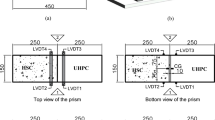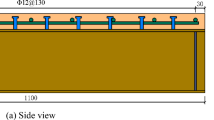Abstract
The primary objective of the research reported in this paper was to evaluate the effect of using self compacting concrete on the bond strength and mode of bond failure of tension lap splices anchored in normal strength concrete (NSC). Studies on the effect of transverse reinforcement on anchored reinforcement in self compacting concrete to prevent brittle mode of failure is limited. To meet this objective, full-scale NSC beam specimens were tested. Each beam was designed with bars spliced in a constant moment region at mid-span with various levels of stirrup confinement. The slip of the reinforcement with respect to concrete is also measured by providing notches at the end of the splices. Test results indicated that there is an increase in the bond strength when self compacting concrete is used in place of vibrated concrete. Ductility and splice strength increased as the confinement increased. When the stirrup spacing is less than 150 mm, the failure in the splice region was by yielding of steel. The influence of confinement on the crack formation of the beams is also reported.





Similar content being viewed by others
References
Orangun CO, Jirsa JO, Breen JE (1977) A reevaluation of test data on development length and splices. ACI J 74:114–122
David D, Tholen ML, Idun EK, Zuo J (1996) Splice strength of high relative rib area reinforcing bars. ACI Struct J 93(1):95–107
Zuo J, Darwin D (2000) Splice strength of conventional and high relative rib area bars in normal and high strength concrete. ACI Struct J 97(4):630–641
Eligehausen R, Popov EP, Bertero VV (1983) Local bond stress–slip relationships of deformed bars under generalized excitations. UCB/EERC83-23, Earthquake Engineering Research Center, University of California, Berkeley
Harajli MH, Hout M, Jalkh W (1995) Local bond stress slip behavior of reinforcing steel bars embedded in plain and fiber concrete. ACI Mater J 92(4):343–354
Harajli MH, Hamad BS, Karam K (2002) Bond–slip response of reinforcing bars embedded in plain and FRC. ASCE J Mater Civil Eng 14(6):503–511
Harajli M, Al-Hajj J (2002) Bond stress–slip response of reinforcing bars in high-strength concrete. In: Bond in concrete—from research to standards. Proceedings of the international symposium, Budapest, Hungary, pp 570–577
Esfahani MR, Rangan BV (1998) Bond between normal strength and high strength concrete and reinforcing bars in splices in beams. ACI Struct J 95(3):272–280
Harajli M, Mabsout ME (2002) Evaluation of bond strength of steel reinforcing bars in plain and fiber-reinforced concrete. ACI Struct J 99(4):509–517
Harajli MH (2004) Comparison of bond strength of steel bars in normal and high-strength concrete. J Mater Civil Eng ASCE 16(4):365–374
Dehn F, Hoalschemacher K, Weibe D (2000) Self compacting concrete (SCC) time development of the material properties and the bond behavior. Selbstverdichtendem Beton
Brameshuber W, Stephan V, Christian T (2001) Self compacting concrete in the precast element plant. BFT 1:80–88
Chan YW, Chen YS, Liu YS (2003) Development of bond strength of reinforcement steel in self consolidating concrete. ACI Struct J 100(4):294–301
Zhu MW, Bartos PJM (2007) The bond and interfacial properties of reinforcement in self-compacting concrete. Cem Concr Compos 29:1–12
IS 1786 (1985) Specification for high strength deformed steel bars and wires for concrete reinforcement. Bureau of Indian Standards, New Delhi, India
IS 3812 (2003) Pulverised fuel ash—specifications part I: for use as Pozzolona in cement, cement mortar and concrete. Bureau of Indian standards, New Delhi, India
IS 8112 (1989) Specifications for 43 grade ordinary Portland cement. Bureau of Indian Standards, New Delhi, India
Peterson O, Bill berg P, Van BK (1996) A model for self compacting concrete. In: Proceedings of 1st international RILEM conference, Paiseley, Scottland, June 1996, pp 483–492
Okamura H, Ozawa K, Quchi M (2000) Self compacting concrete. Struct Concr 1(1):3–17
Kwan AKH (2000) Use of condensed silica fume for making high strength, self-consolidating concrete. Can J Civil Eng 27(4):620–627
Su N, Hsu KC, Chai HW (2001) A simple mix design method for self-compacting concrete. Cem Concr Res 31:1793–1798
Sack W, Jennings HM, Shok SP (2001) New methodology for designing SCC. ACI Mater J 98(6):429–439
Subramanian S, Chattopadhyay D (2002) Experiments for mix proportioning of SCC. Indian Concr J 18:13–20
Gettu R, Izquierdo J, Games PCC, Josa A (2002) Development of high-strength self compacting concrete with fly ash, a four-step experimental methodology. In: Proceeding of 27th conference on our world in concrete & structures, Singapore, pp 217–214
Malathy R, Govindaswamy T (2006) Development of mix design chart of various grades of self-compacting concrete. ICI J 6:19–23
Xie Y, Liu B, Yin J, Zhou S (2002) Optimum mix parameters of high-strength self-compacting concrete with ultrapulverized fly ash. Cem Concr Res 32(3):477–480
Ghezal A, Khayat KH (2002) Optimizing self-consolidating concrete with limestone filler by using statistical factorial design methods. ACI Mater J 99(3):264–272
Okamura H, Quchi M (2003) Self compacting concrete. J Adv Concr Technol 31:5–15
Okamura H, Ozawa K (1994) Self-compactable high-performance concrete in Japan. ACI SP-159. American Concrete Institute, Farmington Hills
The European Guidelines for Self-Compacting Concrete: Specifications, Production and Use, 2005. http://www.efnarc.org/pdf/SCCGuidelinesMay2005.pdf
Babu GK, Dinakar P (2006) Self compacting concrete with fly ash. Master Build 7:52–56
Rajamane NP, Annie Peter J (2006) Self compacting mix proportioning and chemical admixtures. Master Build 7:35–43
Safiuddin M (2008) Development of self-consolidating high performance concrete incorporating rice husk ash. PhD thesis, University of Waterloo, Canada
ACI Committee 408 (2003) Bond and development of straight reinforcing bars in tension. American Concrete Institute, Farmington Hills
Unnikrishna Pillai S, and Menon D (2003) Reinforced Concrete Design. Tata Mc Graw Hill, New Delhi, India, 2003:392
Author information
Authors and Affiliations
Corresponding author
Rights and permissions
About this article
Cite this article
Pandurangan, K., Kothandaraman, S. & Sreedaran, D. A study on the bond strength of tension lap splices in self compacting concrete. Mater Struct 43, 1113–1121 (2010). https://doi.org/10.1617/s11527-009-9570-3
Received:
Accepted:
Published:
Issue Date:
DOI: https://doi.org/10.1617/s11527-009-9570-3




